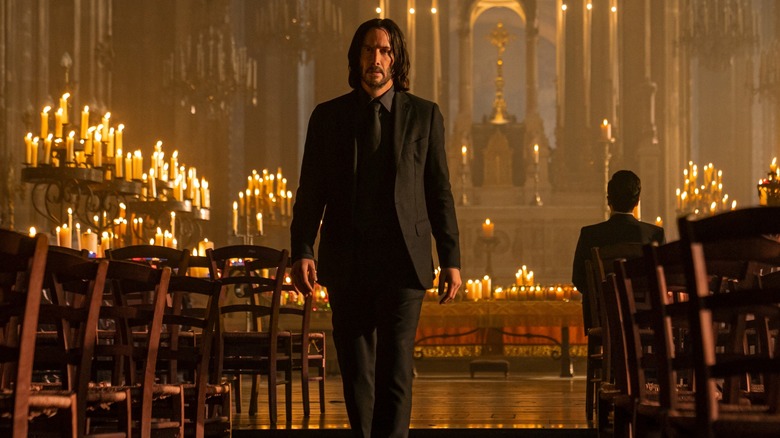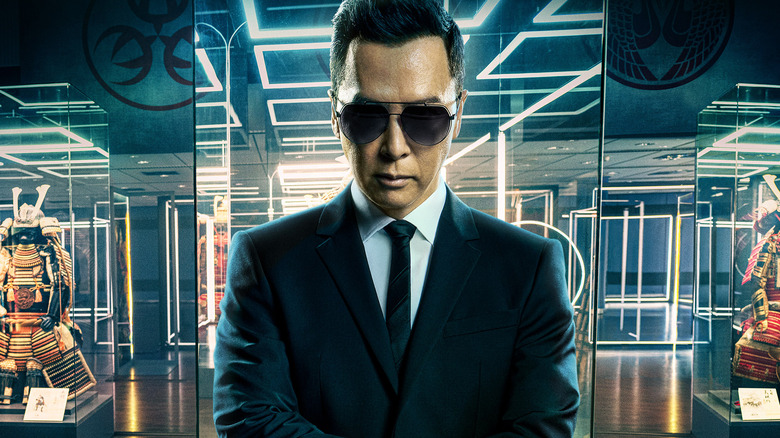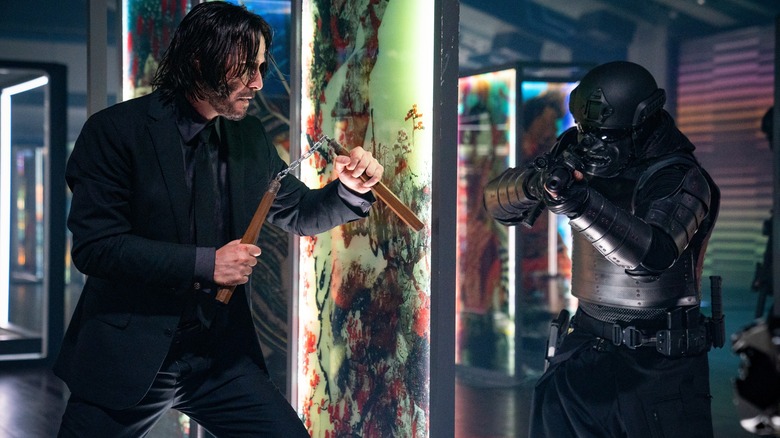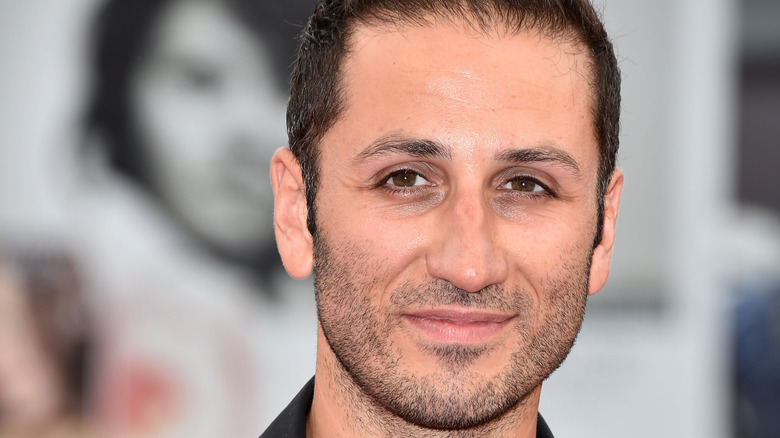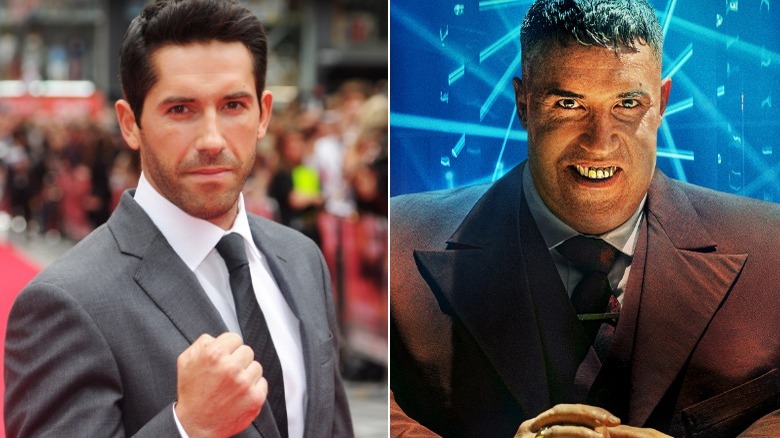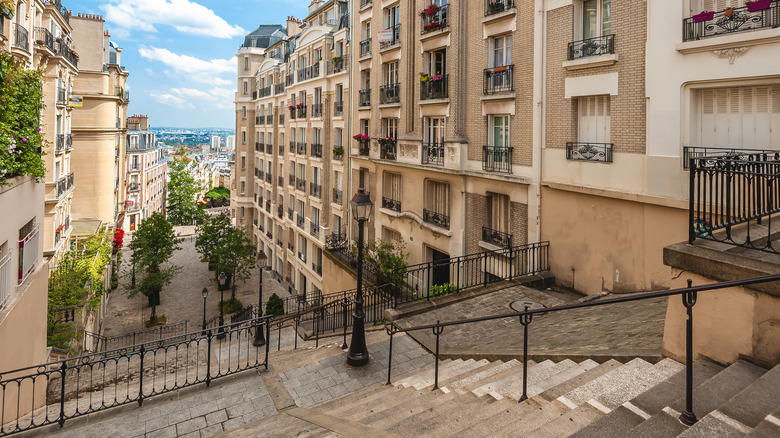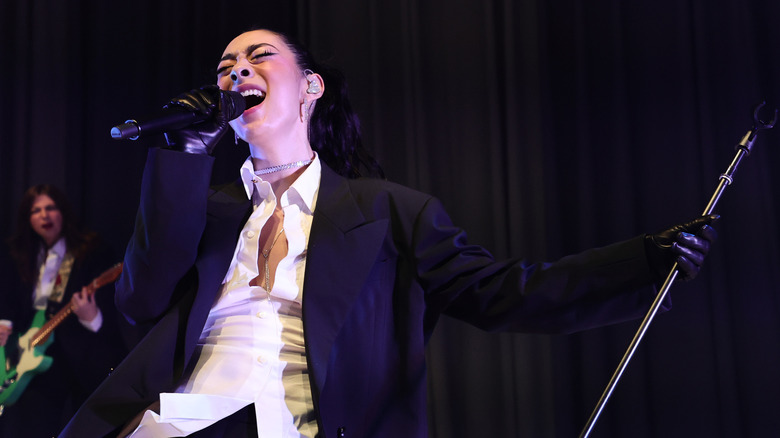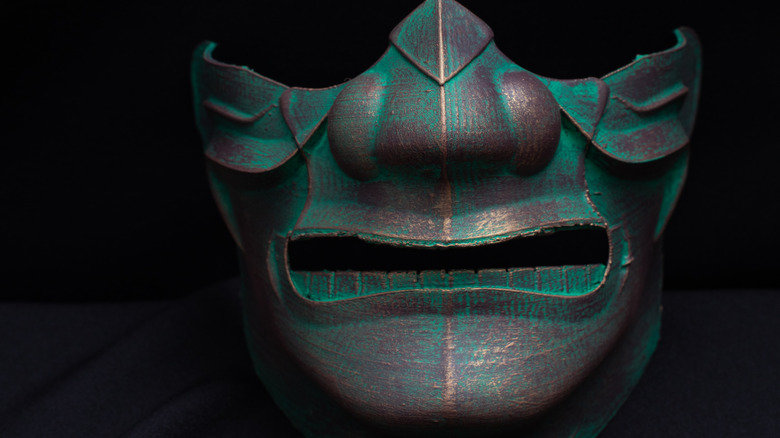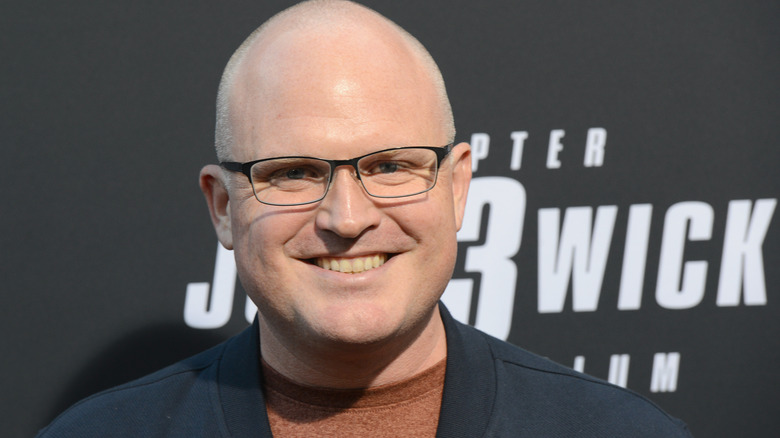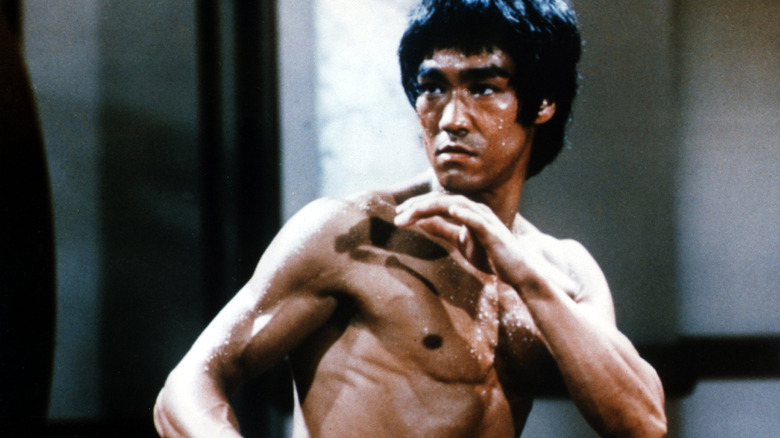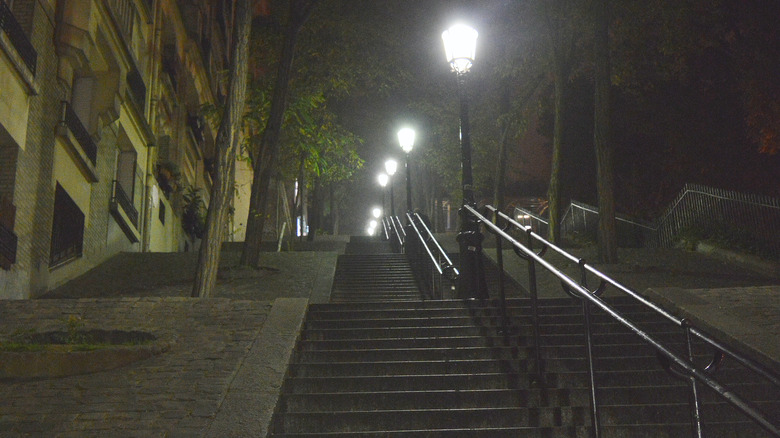Small Details You Missed In John Wick: Chapter 4
After four year of eager anticipation between sequels, "John Wick: Chapter 4" hit theaters with its fanbase rabid for more. The fourth outing delivers an explosive blast of action from the dog-loving assassin, while continuing to expand its impressive world building and innovative, creative methods with which John dispatches those who would oppose him. With new locations, new characters and lots of new kills, "Chapter 4" is perhaps the franchise film most dense with details.
Not many action franchises have raised the bar with each subsequent outing, but in many ways it feels like the "John Wick" movies are hitting their stride later than most. While plotlines may remain relatively straight forward, the world these films have built continues to pay off, making the franchise feel unique, packed with little details that will fly under the radar for some.
With "Chapter 4" the longest movie in the series, there are plenty of Easter eggs, references, and trivia factoids to sift through. Below, some of the most spoiler-heavy, but also some of the best.
The post-credits scene
When the film concludes, make sure you keep an eye on the credits. Since none of the prior "John Wick" movies had post-credits scenes, you'd be forgiven for thinking "Chapter 4" followed suit, but that's not the case. This post-credits scene is more substantial than those in most movies, and is important for both the story of this film and the future of the franchise.
The scene picks up following the events of the movie; Caine (Donnie Yen) has earned freedom for himself and his daughter. With a bouquet of flowers in hand, Caine finally heads toward his violinist daughter, whom he has had to stay distant from for years for her own safety. Before he reaches her, however, Akira (Rina Sawayama) intercepts him. Caine killed her father while he was forced to work for The Marquis, and she has come for revenge after recovering from the gunshot wound she sustained at the Osaka Continental. As Akira approaches him and produces a knife, the scene ends, leaving "Chapter 4" on a surprising, post-credits cliffhanger.
This could set up a spinoff that explores the clash between Caine and Akira, and the ripples throughout the assassin world that would follow. Both are likable characters and have compelling reasons behind their actions, making for a more nuanced conflict than the typically black and white heroes and villains of the other "Wick" movies.
Film references
The "John Wick" series has always had a penchant for paying tribute to other movies, and "Chapter 4" continues this trend.
First up is "Lawrence of Arabia," and the 1962 epic's memorable shot hailed by some as the greatest single cut of all time, jumping from Peter O'Toole blowing out a match to the desert horizon at sunrise. "Chapter 4" replicates the transition by having the Bowery King (Laurence Fishburne) blow out a match, then cutting to the desert horizon where John is engaged in a horse chase.
Later on, there is a reference to Quentin Tarantino's "Kill Bill," with Caine (Donnie Yen) telling Akira he will be waiting for her to take revenge after he kills her father; it's the same message The Bride (Uma Thurman) delivers to Vernita Green's daughter after killing her mother. Caine's character, a blind assassin who fights primarily with a sword, is similarly in the tradition of the Japanese "Zatoichi: The Blind Swordsman" series, which ran for 25 films with its mainline entries alone, not to mention other films and television that has incorporated the character.
There is also subtle homage to Walter Hill's wild 1979 classic "The Warriors," as both movies have a radio DJ tracking the heroes as they work their way through a city of enemies. Both films shoot the DJ in extreme close-ups, rendering them both intimate and anonymous, with only a mouth and microphone visible. Tarantino similarly cribbed the shot in "Pulp Fiction" when Mia Wallace talked to Vincent Vega through her house intercom.
A different Elder
The so-called "Elder" is one of the more mysterious figures in the entire "John Wick" universe, which is really saying something. First introduced in "John Wick: Chapter 3 — Parabellum," John made an arduous trek through the desert just to reach him. At different points, The Elder has been described as being the head of the High Table, even perhaps above the High Table altogether. He calls the shots, makes the rules for the entire assassin underworld, and holds a position of extreme importance — which makes it extra noteworthy that he was replaced between movies.
In "Chapter 3," The Elder was played by Saïd Taghmaoui, veteran of films like "La Haine" and "Wonder Woman." For "Chapter 4," the role was recast with George Georgiou (pictured above).
With this recasting, The Elder's presence has gone from minor supporting character in "Chapter 3" to an even smaller presence in "Chapter 4"; the character only has a couple of lines before John kills him. The appearance is so brief, in fact, that many may not even realize the recasting. "Chapter 4" does actually include a quick line of dialogue about how the current Elder replaced the former one, but there is no clear reason for why this changing of the guard occurred, and Wick was not involved in it. No reason has been made public for why Taghmaoui didn't return as The Elder; perhaps it came down to simple scheduling conflicts (the film was delayed multiple times due to the pandemic), or perhaps Taghmaoui wasn't worth bringing back for such a small amount of screentime.
That is Scott Adkins under there
Skilled martial artist and action movie veteran Scott Adkins plays the role of Killa in "John Wick: Chapter 4." But unless you are a hardcore action movie fan and regularly view Adkins' frequent direct-to-video movies, you might not recognize him.
Killa is John's assassination target in Berlin: An obese, card-dealing nightclub gangster with asthma. John needs to kill him in order to secure the support of the Ruska Roma and use their crest to challenge the Marquis to a duel.
For the role, the fit Adkins was hidden behind extensive prosthetics, wearing a fatsuit that completely changes his body type to make him nearly unrecognizable. Adkins is from England and typically plays characters that either have British or American accents, but here he uses a German one. Another eye-catching design element of Killa is his gold teeth, perhaps a reference to the gold-toothed character Atkins played in 2019's "Avengement." Getting even more granular, this is the second time that Adkins has been at odds with Donnie Yen in a fourth installment of an iconic action series. He first fought Yen's main character in "Ip Man 4: The Finale" in 2019, playing the main villain, a racist American Army sergeant.
The re-used needle drop
Perhaps the most iconic scene from the original "John Wick" film came via an extended action sequence in the Red Circle nightclub. Part "4" brings the beat back.
The first part of that sequence took place in the bathhouse below the club, scored by the Kaleida song "Think." Once the shootout progressed upstairs to the dance floor, the soundtrack kicked into high gear, as the Le Castle Vania song "LED Spirals" took over. The song was named after the swirling black and white imagery displayed on the nightclub's LED screen and composed for the film, not part of the original score from composers Tyler Bates and Joel J. Richard.
Three movies later, the same needle drop gets a reprise in "John Wick: Chapter 4." The song plays again during one of the film's best shootouts, this time while John goes wild with Dragon's Breath shotgun shells. In another soundtrack filled with memorable songs, "LED Spirals" once again stands out, pulling off the impressive feat of being the only track to become a musical highlight of multiple "John Wick" films.
The staircase is famous
The big, show-stopping action sequence at the end of "John Wick: Chapter 4" involves the titular character's deadly ascent up a massive staircase. John needs to meet the Marquis (Bill Skarsgård) at La Basilique du Sacré Cœur de Montmartre at sunrise for a duel. But to get there, he first needs to fight his way past dozens of armed thugs and climb the 222 steps to the top of the hill.
In reality, the staircase does consist of 222 steps and leads directly to the Sacré-Cœur Basilica, just as it does in the movie. The staircase is big enough to be considered its own street in the Montmarte district of Paris and is known as Rue Foyatier. The location is a popular tourist attraction, a frequent subject of acclaimed photographers, and has been featured in other movies including the 1984 French film "Les Ripoux" (AKA "My New Partner)"; parts of the steps and the Sacré-Cœur Basilica were also home to an important sequence in "Amelie," and a matching staircase on the opposite side of the hill was used for the opening scene of the John Frankenheimer flick "Ronin."
In real life, there are cable cars that go up and down the hill right beside the staircase. These were, of course, hidden from view in the film, as John's ascent would have been made significantly easier if he could have just hailed a cable car.
Akira was a debut performance
One of the most memorable new characters introduced to the "John Wick" world in "Chapter 4" is Akira, played by Rina Sawayama. Though she exits the film when John leaves Japan, Akira leaves a significant impression throughout the extended Osaka portion of the movie. She is the daughter of Shimazu (Hiroyuki Sanada), the Osaka Continental manager, and proves herself to be one of the most skilled fighters in the entire series, helping John take down numerous heavily-armored High Table soldiers.
"John Wick: Chapter 4" is Sawayama's feature-film debut performance, but you would likely never guess that was the case since she easily holds her own with the rest of the cast when it comes to both the acting and the action. Her physical performance is especially impressive, and the unique fighting style employed by her character helps her stand out. Sawayama's only previous acting experience was a small part in the forgotten 2019 Idris Elba-starring Netflix series "Turn Up Charlie." But Sawayama is a well-known musician; Lady Gaga has described the Japanese-British star as "an experimental pop visionary," she has recorded a duet with Elton John, released a new album in late 2022and also has a successful career as a fashion model.
The Menpo
"John Wick: Chapter 3 — Parabellum" was the first movie in the series to introduce the heavily-armored soldiers who work for the High Table. These enemies were not just highly skilled and equipped with better weaponry than Mr. Wick's typical adversaries, but they were also practically bulletproof, requiring him to get creative and get up close and personal to take them out.
These heavily-armored High Table soldiers make a welcome return in "Chapter 4." This time, however, they show up in Osaka, Japan as opposed to New York City. Their bulletproof armor is made of the same black material but has now been altered slightly to better suit the Japanese setting. They now more closely resemble the armor worn by Samurai warriors back in the days of feudal Japan, particularly in the new design of their face masks.
While the NYC High Table soldiers wore blank ballistic helmets, the masks of their Osaka counterparts more closely resemble Menpo — traditional, intricate half-masks worn by Samurai. Not only is this fitting for the Japanese setting, but it is also a nice way to pay tribute the old samurai movies that contributed to the inspiration behind all the swordplay in "Chapter 3" and "Chapter 4."
The writing changed hands
If "John Wick: Chapter 4" feels distinctly different from the previous films in a big way, it might be because it was written by different people. From the director, to the producers, to the stars, the same creative team has remained largely consistent throughout the series; the one major creative fluctuation, however, has been Derek Kolstad.
Kolstad was the original screenwriter of the first movie, back when it was just a spec script titled "Scorn." He was the lone screenwriter on "John Wick: Chapter 2" as well. When "Chapter 3 — Parabellum" rolled around, Kolstad remained involved, but other writers began getting their hands dirty as well. He retained sole "story by" credit, but was now just one of four screenwriters contributing to the screenplay.
By "Chapter 4," Kolstad was out of the picture entirely. Kolstad has been open about the fact that it wasn't his decision to leave the series, saying the studio simply didn't invite him back. Kolstad has kept busy in the meantime, however, with the "John Wick"-flavored action movie "Nobody," as a member of the writing team on "The Falcon and the Winter Soldier," and as co-creator of the Quibi/Roku series "Die Hart." The extent of his involvement in the upcoming "The Continental" spin-off TV series remains to be seen.
Caine was inspired by Bruce Lee
Long before he made the transition to English-language films, Donnie Yen became a legend within the Hong Kong action film industry. He has always called Bruce Lee his idol, and he saw an opportunity to take influence from and pay tribute to Lee in "John Wick: Chapter 4." As mentioned in the official Lionsgate production notes for "Chapter 4," Yen chose Caine's wardrobe himself. He based the look on an outfit worn by Lee, out of character, in an old interview: A black and white suit and shirt with a skinny black tie.
Since he had already played a blind fighter in "Rogue One," Yen was on the lookout for ways to separate the two characters and help them stand apart. Plenty of distinguishing detail was in the script and choreography already, but Yen chose to play up Caine's personality as a cross between Bruce Lee and American actor Steve McQueen, who had a reputation as the King of Cool.
The Lee influence can be seen in the aforementioned wardrobe, along with some of Caine's mannerisms. The McQueen influence can also be seen in Caine's relaxed, nonchalant attitude, even as bullets are flying and swords are swinging. As Caine takes his time to calmly eat and drink in the middle of an action sequence, it's hard to not see those two legendary tough guys.
The staircase callback
The massive set piece at Rue Foyatier serves as the action climax of "John Wick: Chapter 4" before the story comes to a close with the slower-paced duel at La Basilique du Sacré Cœur between John and Caine, who is taking the place of the Marquis. After John painstakingly fights to the top of the 222 step staircase, Chidi (Marko Zaror) ambushes him with a kick that sends him tumbling all the way back down.
The fall is so long and drawn out that it becomes hilarious, even as you feel bad for John's pain and struggle. Die-hard fans of the "John Wick" series will recall that this is actually the second time the series has used a prolonged fall down a huge staircase for a joke in the middle of a big action sequence. The previous iteration was back in "Chapter 2," during the portion of the film set in Italy. As John and Cassian (Common) were fighting, they repeatedly tumbled down several flights of steps in comically exaggerated fashion, finally winding up in a courtyard below where they continued to duke it out. For a series as kinetic as "John Wick," it feels fitting for its version of a callback to be based not in dialogue but rather in a physical stunt.
